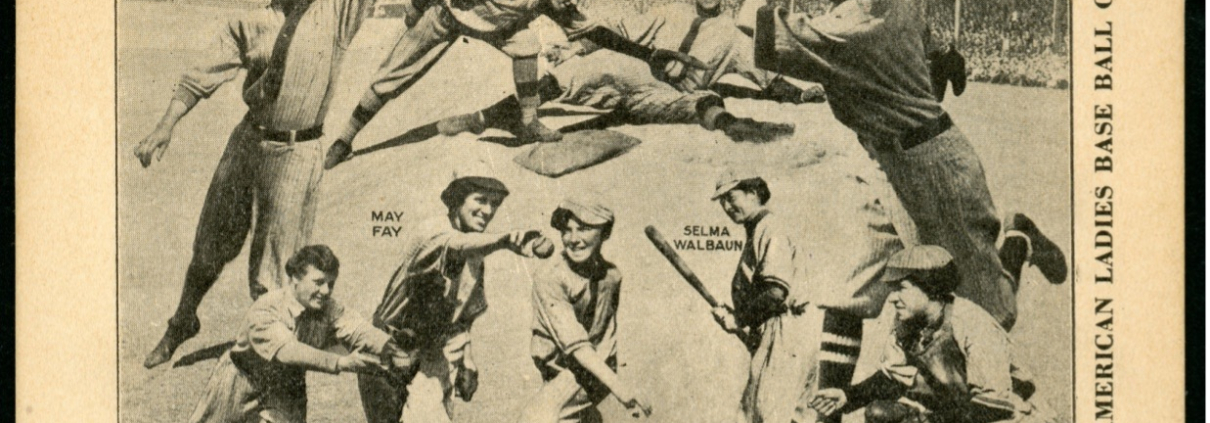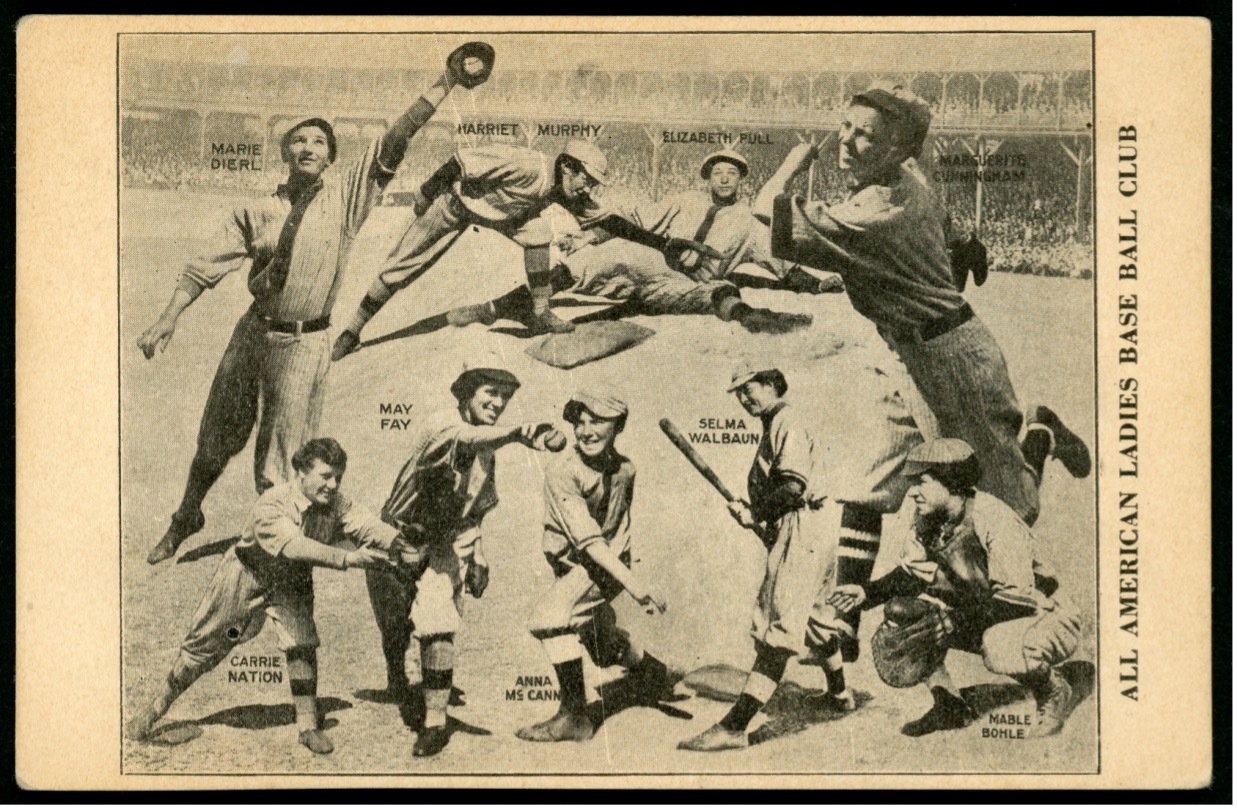July 3, 1915: Barnstorming American women compete against male semipros in Saskatchewan
In 1915, a baseball team with female players was a novelty that could attract a paying audience. One such team calling itself the All-American Girls toured western Canada that year. In Saskatoon, Saskatchewan, on Saturday, July 3, 1915, this team of six women and three men were defeated by an all-male team of local semipros. Though defeated, the ladies played well. Two Saskatoon newspapers, the Phoenix and Star, published accounts of the game.
The All-American Girls were led by Mae Arbaugh, a 30-year-old woman who called herself Carrie Nation, after the famous hatchet-wielding temperance crusader. Arbaugh served as the team’s first baseman and cleanup hitter, and was the team comedian. She was an accomplished ballplayer. Her lengthy résumé included a stint as a 16-year-old left fielder on the Boston Bloomer Girls of 1901.1 She understood that baseball was entertainment and her witty remarks enhanced the show. “It’s worth the price of admission alone” to hear “her funny sayings,” said the Calgary Albertan.2
Pitching that day in Saskatoon was Elizabeth Pull, a 25-year-old right-hander nicknamed “Fargo” after her hometown in North Dakota. She was billed as “the champion lady pitcher of the world.”3 Though weighing only “about 100 pounds,”4 she threw fastballs with “plenty of speed” and her breaking ball was “exceptionally good.”5 In a throwing competition, she hurled a ball 298½ feet.6 In 1912 she and Arbaugh were possibly the only women to play for J.L. Wilkinson’s barnstorming All Nations team.7
The all-female outfield of the All-American Girls included Bessie Barrett in left field, Julia St. Clair in center, and May Fay in right. St. Clair had been Arbaugh’s teammate as far back as 1901.8 Like Arbaugh, Fay hailed from Kansas City.9
Harriet “Happy” Murphy played second base with pep and style.10 The lineup was filled out by men: Claude at shortstop, Dowd at third base, and Creed catching.
Jack Lowes, the proprietor of a Saskatoon clothing store, assembled the all-male team of semipros and he put himself in left field. Leading off and playing second base was Bill Donovan, “one of the best-known baseball players in western Canada.”11 Rounding out the infield were Whitehall at first base, Irish Millar at shortstop, and Cliff Mugridge at third. Joining Lowes in the outfield were Wilson in center field and Graves in right. The battery was Pete McGuire pitching and Ernie Hewer catching. Hewer was the cleanup hitter. He and Donovan had played minor-league baseball in the Class D Western Canada League.
The game was played at Cairns Field, which opened in the spring of 1914. It was named for its builder, James Frederick Cairns, a prominent local merchant.12 The grandstand and bleachers could accommodate 4,000 people.13 The attendance for this contest, reported to be 807, was the largest of the 1915 season at the new ballpark. It was a cool July day, with the temperature near 60 degrees. The game commenced at 3:30 P.M.
The Semipros got on the scoreboard with an unearned run in the first inning and another in the third, taking advantage of errors by men on the Girls’ team. Mugridge tripled in the first inning and scored on an error by Dowd. In the third inning, Millar singled, stole second and third, and came home on an error by Claude.
The Girls threatened in the top of the fifth but failed to score. Murphy led off with a single and went to third on Fay’s single, but three groundouts followed to stymie the effort.
In the bottom of the fifth, Dowd’s second error of the game led to two more unearned runs for the home team. Millar doubled with one out and scored on Dowd’s error. Mugridge reached second base on the miscue, moved to third on an infield out, and came home on Whitehall’s single. After walking Wilson, Pull cleverly picked off Whitehall at second base to end the rally.
The Girls got one back in the top of the sixth, with singles by Creed and Dowd. But in the bottom half, the Semipros tallied three more unearned runs. With two outs, McGuire reached on Murphy’s error and went to third on Donovan’s single. Millar followed with a two-run triple. Claude fielded Mugridge’s grounder and threw wide to first, allowing Millar to score and Mugridge to reach second base. Pull again picked the runner off second base to stop the bleeding.
The Semipros added another run in the eighth. After McGuire’s single, Donovan lifted a fly ball to deep right field. It was a difficult play, close to the fence, and Fay was charged with an error for failing to catch it. Millar singled for his fourth hit of the game, scoring McGuire.
The Girls scored a run in the ninth. Pull singled and went to third on Murphy’s single. Pull came home on the front end of a double steal, while Murphy was erased on the back end.
The final tally was Saskatoon Semipros 8, All-American Girls 2. Pull pitched a complete game, allowing eight runs, all unearned, on 10 hits. She struck out three and walked two. The Star said she “had splendid control and used a nice drop with good effect.”14
Collectively, the six women went 5-for-22 (.227) at the plate and committed two errors in 28 chances (.929) in the field. On the other hand, the three men on their team went 2-for-11 (.182) and made four errors in 18 chances (.778). “It was a surprise to many the way the girls tossed the ball around with as much ease and confidence as any old ball players,” said the Phoenix. The three men “were the poorest part of the aggregation.”15
The crowd was “highly pleased with the exhibition of ball put up,” noted the Phoenix. “Carrie Nation’s work on first was good, and the continual line of talk she kept up amused the fans as much as the game itself.”16
Epilogue
Mae Arbaugh, aka Carrie Nation, continued to play on barnstorming teams into her mid-40s. According to a Ripley’s “Believe It or Not” published in 1929, she played in 4,600 games in 33 years.17
Elizabeth Pull also played into her mid-40s. In a 1950 interview, she said she had pitched to Honus Wagner and Babe Ruth, and played with and against Satchel Paige.18
Acknowledgments
This article was fact-checked by Kevin Larkin and copy-edited by Len Levin.
Sources
Game coverage in the July 5, 1915, issues of the Saskatoon Phoenix and Saskatoon Star.
Eberle, Mark E. “Who’s on First? Kansas City’s Female Baseball Stars, 1899-1929” (2019). Monographs. 10. scholars.fhsu.edu/all_monographs/10.
Garlie, Gracen. “Elizabeth Pull: The Woman Who Defied Barriers and Expectations in Baseball” (2018). nhdinwi.weebly.com/uploads/2/8/9/9/28997259/eau_2018_junior_division_gracen_garlie_elizabeth_pull_the_women_who_defied.pdf.
Notes
1 “The Boston Bloomers,” Stockton (Kansas) Western News, May 2, 1901: 5.
2 “Baseball Girls Put Up a Good Ball Game,” Calgary Albertan, July 21, 1915: 2.
3 “All American Girls Club Is Coming July 3,” Saskatoon (Saskatchewan) Star, June 23, 1915: 13.
4 “Locals Win One,” Sauk Centre (Minnesota) Herald, September 2, 1915: 3.
5 “Baseball Girls Put Up a Good Ball Game.”
6 James E. Kelley, “Kokomo Woman Recalls Memorable Events of Unusual Diamond Career,” Kokomo (Indiana) Tribune, October 25, 1950: 5.
7 “Storz-Trumps Play the All-Nations Today,” Omaha News, May 12, 1912: 26; “Woman Will Umpire,” Fargo (North Dakota) Forum and Republican, July 2, 1912: 3.
8 “The Boston Bloomers.”
9 “Bloomer Girls,” Kansas City Globe, April 9, 1910: 1.
10 “Baseball Girls Put Up a Good Ball Game.”
11 “Bill Donovan Has Faith in Hurley,” Saskatoon Phoenix, May 10, 1913: 8.
12 Donald Cameron Kerr, “Cairns, James Frederick,” in Dictionary of Canadian Biography, vol. 15, University of Toronto/Université Laval, 2003–, biographi.ca/en/bio/cairns_james_frederick_15E.html.
13 “New Grounds and Modern Grandstand for Saskatoon Baseball Club This Year,” Saskatoon Phoenix, March 28, 1914: 8.
14 “Saskatoon Semi-pros Defeat All American Girls in Good Game,” Saskatoon Star, July 5, 1915: 13.
15 “Over 1,000 Fans Watched Lowes’ Team Defeat All American Girls by 8-2,” Saskatoon Phoenix, July 5, 1915: 7.
16 “Over 1,000 Fans Watched Lowes’ Team Defeat All American Girls by 8-2.”
17 Ripley’s “Believe It or Not,” Edmonton (Alberta) Bulletin, November 8, 1929: 19.
18 Kelley, “Kokomo Woman Recalls Memorable Events of Unusual Diamond Career.”
Additional Stats
Saskatoon Semipros 8
Barnstorming American Women 2
Cairns Field
Saskatoon, Saskatchewan
Corrections? Additions?
If you can help us improve this game story, contact us.



